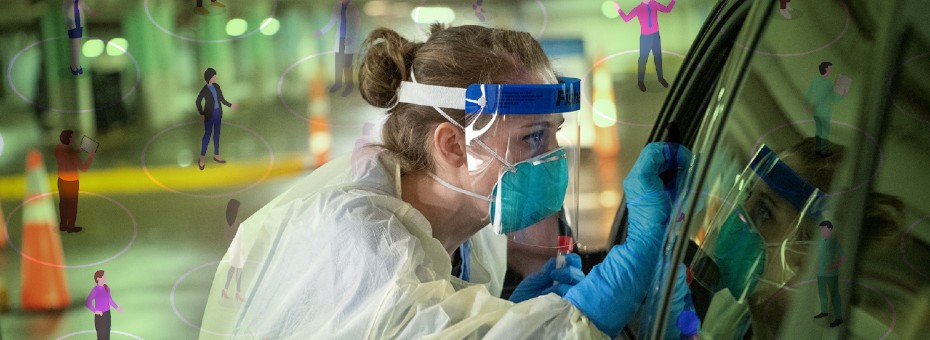As 2020 gave way to 2021 with rapidly evolving situations, the profound challenge of living through a pandemic and a pandemic-infected global economy called for new ways of thinking. And if we have learned a lesson from the pandemic of 2020, it is this: We must always be prepared to solve the next problem. This pandemic is just one; the next one is on its way.
As part of an online event, the 2020 LEI Virtual Lean Experience, which explored the nature of work, the design and execution of work, the role of leaders in a crisis, and ways of building learning and humanity into work, we shared a presentation with the curious title of “Jidoka 2020.” In the presentation, we discussed lessons that Lisa and her Cleveland Clinic colleagues learned as they used lean thinking and practices to grapple with the Covid-19 pandemic. We framed the discussion about this work by comparing it with essential Toyota lean principles and practices. Moreover, we identified and shared several key principles others can apply to prepare their organizations to respond to future crises.
How Well Are We Learning
Since our session in the fall, things have changed. The pandemic has worsened considerably. Social unrest (here in the United States, but in many other parts of the world, too) reached new highs in March 2021. The economy continued to march to dual realities — one for Wall Street and another for Main Street, with still more divisions on Main Street, such as big winners like logistics providers and big losers like your favorite restaurant. This year, the pandemic crisis abated while still generating problems to address.
The bedrock for making the most of opportunities and resolving crises in the future will be adaptive learning: how well we learn and how we go about learning will determine how successful we will be.
Just as 2021 was very different from 2020, every year after that augers more changes — perhaps not altogether “better,” but fundamentally different in at least one crucial way. A new year brings the opportunity to choose to shape 2021 in desirable ways. Last year’s events threw many of us solidly into reactive mode. Human organizations, it seems, work more effectively when reacting to clear and present dangers. That’s when humans can be at their best or their worst. In 2021, we had choices to make. How do we filter out the decisions we must make among the many challenges and dilemmas? How to dissect the decision (choice) factors and develop alternatives from which to choose? Finally, we choose. We move forward.
… we need to build the capability and willingness to face the problems squarely and to improve the work to deliver desperately needed value.
How well we do all that will depend on several factors. First, the situation will be dynamic. We will make choices in real time. In few instances will the options — despite dogmatic rhetoric to the contrary — be clear. Each decision will carry plusses and minuses.
The bedrock for making the most of opportunities and resolving crises in the future will be adaptive learning: how well we learn and how we go about learning will determine how successful we will be. Echoing the Lean Transformation Framework questions, we need to build the capability and willingness to face the problems squarely and to improve the work to deliver desperately needed value.
These facts bring us to Cleveland Clinic’s key challenges in Spring 2021: How to test and vaccinate an entire population while keeping testers and vaccinators safe? How to continue with normal daily healthcare work when “normal” seems to have turned upside down?
Tackling Problems with Lean Thinking
Lean thinking and practice offer powerful tools to help us better frame and address profound challenges. The need for groups to learn and grow through facing problems in adaptive and productive ways has never been greater. As Josh Howell related in his letter, “Lean WX—An Rx for Making Things Better,” last November, we can structure work in ways that enable better execution while fostering ongoing adaptive learning. We can intentionally design the work experience for excellence in both the execution of the task and the experience of the human doing it. Designing work in this way enables excellence in execution to create optimum value with minimum waste, learning for continuous improvement, innovation, adaptability, and a more fulfilling human work experience.
We believe applying this way of thinking will help us do better in 2021. And that it has helped us do better at Cleveland Clinic. During our online learning session, Lisa shared how Cleveland Clinic used lean principles to establish drive-through testing quickly and then share it with others.
The core aspects of lean provide essential guidance when tackling crucial challenges.
Though few of us are trained in managing global pandemics, experiencing a crisis is not unprecedented. Cleveland Clinic found that having a pre-existing system for addressing challenges — including a well-established culture with regular check-ins, formal reflection about precedents, and mechanisms for responding to “defects” as they occur — can generate tremendous benefits.
Indeed, we believe their lean system has made it possible for Cleveland Clinic to manage the situation at hand, reflect on the work, and learn how to improve their response to future crises.
Cleveland Clinic operates on a ‘team of teams’ approach and carefully assigns people to ‘do what they are best at.‘
You may be familiar with Cleveland Clinic, a large, academic, nonprofit healthcare system often recognized as one of the world’s best. This 100-year-old institution has always sought excellence not just in the care it provides but also in how it does so. It has long strived to operate on a “team of teams” approach, carefully assigning people to “do what they are best at.”
Cleveland Clinic aims to be the best place to receive healthcare and to be the best place to work anywhere. One of its primary goals is to create a workplace that respects people and provides support to ensure every caregiver is capable, empowered, and expected to make things better for patients and caregivers.
As the Covid crisis emerged, Cleveland Clinic leaders sought to leverage their problem-solving capabilities to help deliver on what matters most: keeping their patients and caregivers safe. One nested system of beliefs and practices is its structured approach to problem-solving — a mindset and technical approach that many have reflected on deeply at Cleveland Clinic.
Three principles guide Cleveland Clinic’s approach to problem-solving:
- Focus on what is the most important problem to solve next.
- Don’t worry about making it perfect; focus on making it better. (When lives are at stake, however, we must strive for perfection.)
- Make rapid feedback available to everyone on the team — in real time at the workplace — so they can quickly gauge how things are going and adjust accordingly. Continuous improvement!
These principles proved extremely useful in March 2020 when Cleveland Clinic began addressing the emerging realities produced by the rapid escalation of coronavirus disease.
To ensure the highest degree of patient and caregiver safety, Cleveland Clinic immediately decided to launch some form of the then-little-understood practice of “drive-through testing.” From the beginning, the approach was to identify, break down, and then iteratively solve this problem.
Initially, the pandemic created a massive cluster of challenges: a limited supply of PPE, too few ventilators, and the need to build surplus capacity for any surge that might occur. Underlying this was that people were solving problems in an environment of fear. They were terrified because they did not know much about the virus.
Solving Drive-Through Problems One at a Time
The team kicked off the drive-through program by gathering supplies and running a simulation of administering the test, in a conference room, with chairs simulating cars. Then, after many rapid PDCA cycles of simulating the testing and reworking their approach, the team rolled out a program that achieved its goals.
Nate Hurle, Lisa’s administrative co-lead of the continuous improvement efforts, describes the approach of the team:
“Together we would decide what that next problem is and then we’d work on that problem for the next 30 minutes. It was this constant series for the next three days of defining what the most important problem to solve is now, and go and work on it. And it was super-fast. We’d say, ‘Okay, this is better than what it was. Great. Now, what’s the next problem to solve?’ We didn’t focus on being perfect. We focused on making it better than what it was.”
As of the end of 2020, Cleveland Clinic reported the results of this approach:
- Over 300,000 tests performed
- Drive-through testing continues at this initial site
- Ongoing PDCA of process and testing methods
- Very few caregiver cases overall
- No caregiver cases traced to patient testing
- Standard work used to build sites at other Cleveland Clinic locations in Ohio and Florida and by other healthcare providers
A few months later, Cleveland Clinic turned its attention to its next problem to solve: safely distributing a flu vaccine to 67,000 caregivers during a global pandemic. This problem, the team fully realized, was a warmup to an even more vexing issue: distributing a Covid-19 vaccine with special handling requirements to millions of patients and 67,000 caregivers.
A robust, socio-technically balanced lean management and operating system was invaluable in helping Cleveland Clinic handle the challenges arising from the pandemic.
Time after time, the team turned to the same lean thinking and practices they had applied back in March and so many times since the start of the pandemic. And they continued to serve them well. For example, at one location (main campus), the team safely distributed nearly 15,000 flu vaccinations in two weeks in a safe and distanced process with a two-minute cycle time. The process went so well that Cleveland Clinic invited caregivers to bring their families in so they could get vaccinated. And a few short months later, they applied the same thinking and practices to the Covid-19 vaccination process.
The pandemic of 2020 reinforces that we must always be prepared to solve the next problem.
We think the presence of a robust, socio-technically balanced lean management and operating system — based on the Lean Transformation Framework — was invaluable in helping Cleveland Clinic handle the challenges arising from the pandemic. We also know that that experience helped others in more ways than one. First, the team immediately (the next week!) helped another healthcare provider in Ohio stand up a drive-through testing site and set up multiple locations throughout the Cleveland Clinic Health System. The team later broadly shared the carefully documented standard work, enabling others to apply it.
We also believe that Cleveland Clinic will benefit from being better prepared for the next crisis, no matter what it is or when it arrives. And we know two things are certain: there will always be more problems, and as each one comes along, ongoing learning will be the key to addressing them better than we did the previous one.
Editor’s Note: This Lean Post is an updated version of an article published on March 2, 2021.








Dear , thank you for updating us about “Are You Ready for the Next Crisis?”.